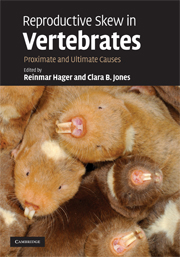Preface
Published online by Cambridge University Press: 02 February 2010
Summary
We have collaborated on projects since 2001, and it became evident to us by 2004 that a book about reproductive skew incorporating theoretical, empirical, and review chapters might be timely. Because of our own research specializations, and because a large body of literature exists on skew in social insects, we generated a plan to prepare a volume on reproductive skew in vertebrates, approaching Cambridge University Press with a proposal. The present text represents our attempt to provide a “state of the art” overview of reproductive skew in vertebrate societies by some of the most active and highly regarded researchers in this field. It is our intention to highlight the most fundamental questions for students of reproductive skew, to assess the strengths and weaknesses of skew models, to critically evaluate skew in insect societies and skew in social vertebrates, and to identify important directions for future theoretical and empirical work.
In her foreword to our volume, Sandra Vehrencamp has provided a brief overview of the history, theory, and empirical highlights of models of reproductive skew. It is clear from her personalized account that advances in the study of reproductive skew (the within-sex partitioning of reproduction within social groups) were presaged by early work in behavioral ecology demonstrating a relationship between dispersion and quality of limiting resources, in particular, food and nesting sites, as well as variations in social behavior, social organization, and mating systems within and between populations. The relationship between these factors is analyzed in models of reproductive skew that attempt to explain the partitioning of reproduction among individuals of the same sex in animals and offer a theoretical framework for understanding the formation of social groups.
- Type
- Chapter
- Information
- Reproductive Skew in VertebratesProximate and Ultimate Causes, pp. xix - xxiiPublisher: Cambridge University PressPrint publication year: 2009

